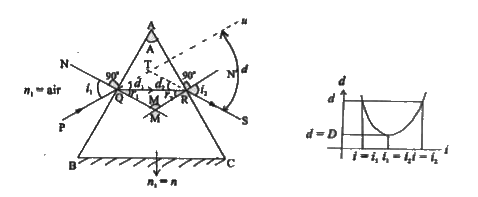Saved Bookmarks
| 1. |
Show thatn=(sin((A+D)/(2)))/(sin((A)/(2))) where symbols have their usual notations. |
|
Answer» Solution :BC - Base of the prism AB and AC - Refracting sides representing the planes ABC - Principle section of prism. PQ - incident ray. RS - emergent ray `d_(1)` - angle of deviation `d_(1)=i_(1)-r_(1)` `d_(2) ` - angle of deviation`d_(2)=i_(2)-r_(2)` `u hatTS `- d - total angle of deviation or net deviation i.e., `d=d_(1)+d_(2)` (exterior angle = sum of two opposite interior angles)  NM is normal to AB at Q N.M is normal to AC at R `i_(1)`- angle of incidence `i_(2)` - angle of emergence. D = angle of minimum deviation, From figure (1) From the quadrilateral AQMR, `A hatQM~=A hatRM=90^(@)` (Nm, N.M are normal to AB and BC) So that `A+M=180^(@)""` ......(1) `THEREFORE `AQMR is a cyclic quadrilateral. From the triangle QMR `r_(1)+r_(2)+hatM=180^(@)("Property of a "Delta) "" `......(2) From (1) and (2) `A+M=r_(1)+r_(2)+M` i.e.,`A=r_(1)+r_(2)""`.......(3) For non-symmetric condition `i_(1) ne i` `d_(1) ne d_(2)` also net deviationd. `d=d_(1)+d_(2)` `d=i_(1)-r_(1)+i_(2)-r_(2)` `therefored=i_(1)+I_(2)-(r_(1)+r_(2))` using (3) we write, `d=i_(1)+i_(2)-A""`.......(4) from the fig., we note that for non-symmetric condition for two angles of incidence, angle of net deviation is the same. However for a symmetric condition, `i_(1)=i_(2)=i and r_(1)=r_(2)=r` net deviation becomes the minimum angle of deviation. In this case the refracted ray will be parallel to the base. `therefore` for symmetric condition, (4)can be written as `D=2i-A` i.e., `i=((A+D)/(2))""` ......(5) (3) can be written as, `A=2r` or`r=((A)/(2))"" ` ......(6) From Snell.s law of refraction at AB, |
|
Discussion
No Comment Found
Related InterviewSolutions
- A wire is bent to form a semicircle of the radius a. The wire rotates about its one end with angular velocity omega . Axis of rotation is perpendicular to the plane of the semicircle . In the space , a uniform magnetic field of induction B exists along the aixs of rotation as shown in the figure . Then -
- A massless non conducting rod AB of length 2l is placed in uniform time varying magnetic field confined in a cylindrical region of radius (R gt l) as shown in the figure. The center of the rod coincides with the centre of the cylin- drical region. The rod can freely rotate in the plane of the Figure about an axis coinciding with the axis of the cylinder. Two particles, each of mass m and charge q are attached to the ends A and B of the rod. The time varying magnetic field in this cylindrical region is given by B = B_(0) [1-(t)/(2)] where B_(0) is a constant. The field is switched on at time t = 0. Consider B_(0) = 100T, l = 4 cm(q)/(m) = (4pi)/(100) C//kg. Calculate the time in which the rod will reach position CD shown in the figure for th first time. Will end A be at C or D at this instant ?
- A concave lens with equal radius of curvature both sides has a focal length of 12 cm. The refractive index of the lens is 1.5. How will the focal length of the lens change if it is immersed in the liquid of refractive index 1.8 ?
- If the tempearture of black body is raised by 5%, the heat energy radiated would increases by :
- What are the co-ordinates of the image of S formed by a plane mirror as shown in figure?
- The direction of ray of light incident on a concave mirror is shown by PQ in Fig. The direction in which the ray would travel after reflection is shown by four rays marked 1, 2, 3 and 4. Which of the four rays correctly shows the direction of reflected ray?
- What is meant by polarisation ?
- Two concentric coils each of radius equal to 2πcm are placed right angles to each other. If 3 A and 4 A are the currents flowing through the two coils respectively. The magnetic induction( in Wb m^(-2) )at the center of the coils will be
- Assertion: Out of ""_(1)He^(3) and ""_(7)He^(3), the binding energy of ""_(1)He^(3)is greater than ""_(2)He^(8). Reason: Inside the nucleus of""_(1)H^(3), there is more repulsion than inside the nucleus of ""_(2)He^(4).
- In which accelerated motion, K.E of the particle is constant